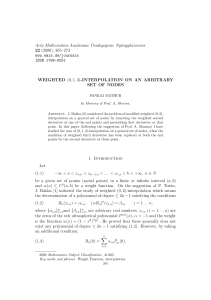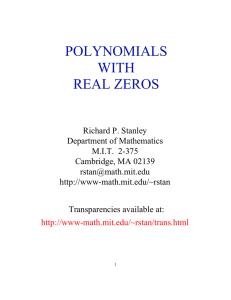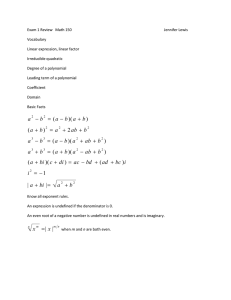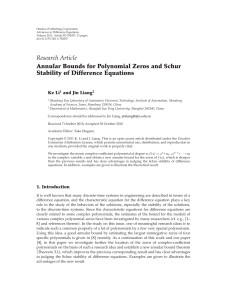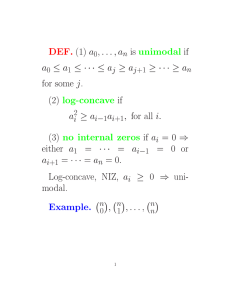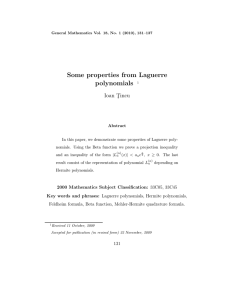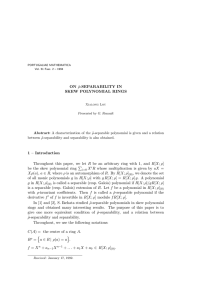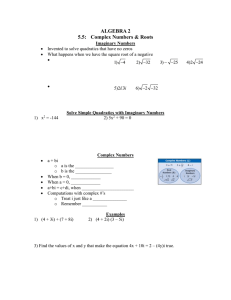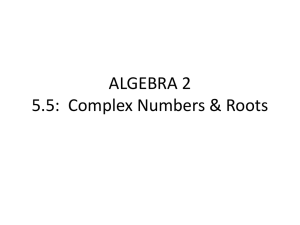Document 10677592
advertisement
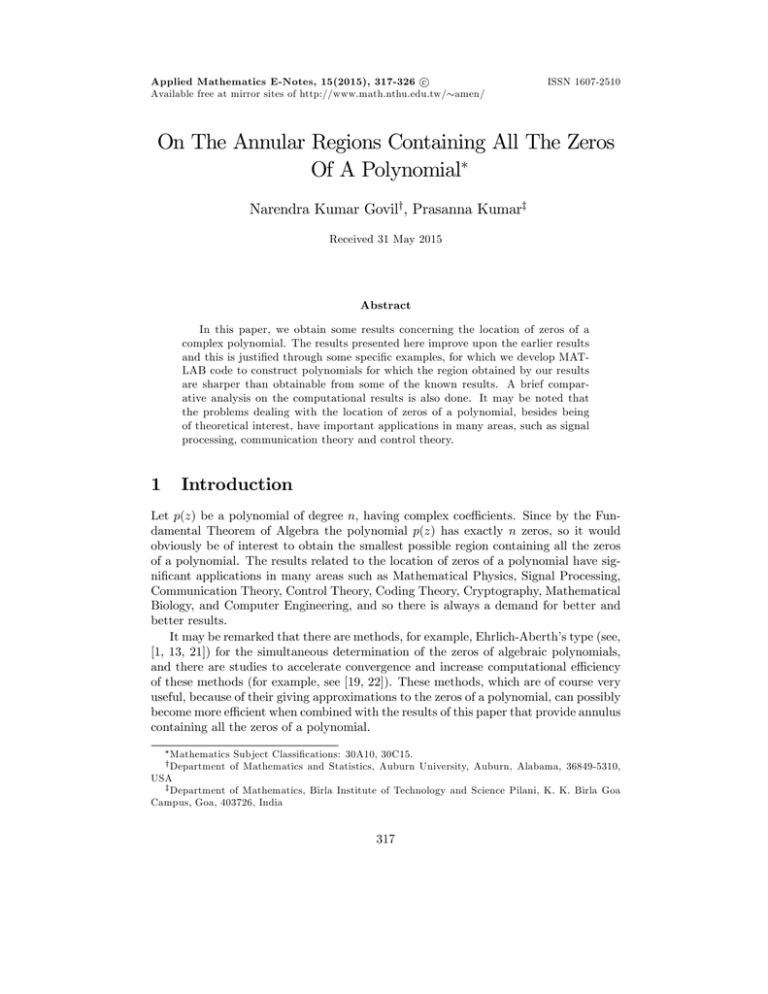
Applied Mathematics E-Notes, 15(2015), 317-326 c Available free at mirror sites of http://www.math.nthu.edu.tw/ amen/ ISSN 1607-2510 On The Annular Regions Containing All The Zeros Of A Polynomial Narendra Kumar Govily, Prasanna Kumarz Received 31 May 2015 Abstract In this paper, we obtain some results concerning the location of zeros of a complex polynomial. The results presented here improve upon the earlier results and this is justi…ed through some speci…c examples, for which we develop MATLAB code to construct polynomials for which the region obtained by our results are sharper than obtainable from some of the known results. A brief comparative analysis on the computational results is also done. It may be noted that the problems dealing with the location of zeros of a polynomial, besides being of theoretical interest, have important applications in many areas, such as signal processing, communication theory and control theory. 1 Introduction Let p(z) be a polynomial of degree n; having complex coe¢ cients. Since by the Fundamental Theorem of Algebra the polynomial p(z) has exactly n zeros, so it would obviously be of interest to obtain the smallest possible region containing all the zeros of a polynomial. The results related to the location of zeros of a polynomial have signi…cant applications in many areas such as Mathematical Physics, Signal Processing, Communication Theory, Control Theory, Coding Theory, Cryptography, Mathematical Biology, and Computer Engineering, and so there is always a demand for better and better results. It may be remarked that there are methods, for example, Ehrlich-Aberth’s type (see, [1, 13, 21]) for the simultaneous determination of the zeros of algebraic polynomials, and there are studies to accelerate convergence and increase computational e¢ ciency of these methods (for example, see [19, 22]). These methods, which are of course very useful, because of their giving approximations to the zeros of a polynomial, can possibly become more e¢ cient when combined with the results of this paper that provide annulus containing all the zeros of a polynomial. Mathematics Subject Classi…cations: 30A10, 30C15. of Mathematics and Statistics, Auburn University, Auburn, Alabama, 36849-5310, USA z Department of Mathematics, Birla Institute of Technology and Science Pilani, K. K. Birla Goa Campus, Goa, 403726, India y Department 317 318 Location of Zeros of a Polynomial The …rst result concerning the location of zeros of a polynomial is probably due to Gauss, who proved that a polynomial p(z) = a0 + a1 z + a2 z 2 + + an z n ; with all ak real, has no zeros outside the circle jzj = R; where p 1 R = max (n 2jak j) k : 1 k n The above result of Gauss was improved by Cauchy [5], who proved that if p(z) = a0 + a1 z + a2 z 2 + + an 1z n 1 + zn is a complex polynomial of degree n; then all the zeros of p(z) lie in the disc fz : jzj < g fz : jzj < 1 + Ag; where A = max1 k n 1 jak j and is the unique positive root of the real-coe¢ cient equation z n jan 1 jz n 1 jan 2 jz n 2 ja1 j z ja0 j = 0: If one applies the above result of Cauchy to the polynomial P (z) = z n p(1=z), one easily gets the following Theorem 1. THEOREM 1 (Cauchy). All the zeros of the polynomial p(z) = a0 +a1 z+ +an z n , an 6= 0, lie in the annulus r1 jzj r2 , where r1 is the unique positive root of the equation jan jz n + jan 1 jz n 1 + + ja1 jz ja0 j = 0; (1) and r2 is the unique positive root of the equation ja0 j + ja1 j z + + jan 1 jz n 1 jan jz n = 0: (2) Although the above Theorem of Cauchy gives an annulus containing all the zeros of a polynomial, it is implicit, in the sense, that in order to …nd the annulus containing all the zeros of a polynomial, one needs to compute the zeros of two other polynomials. The results providing annuli with radii explicitly in terms of coe¢ cients have been given in many papers and books (see [2, 3, 6, 9, 14, 15, 18, 24]), and we begin by stating the following theorem due to Diaz-Barrero [10], which gives an annulus containing all the zeros of a polynomial. THEOREM 2. If p(z) = a0 +a1 z + +an polynomial of degree n; with ak 6= 0; 1 k annulus C = fz : r1 jzj r2 g; where 3 r1 = min 21 k n +an z n is a non-constant complex n, then all the zeros of p(z) lie in the 1z n 1 2n Fk C(n; k) a0 F4n ak 1 k N. K. Govil and P. Kumar 319 and 1 k an k F4n 2n Fk C(n; k) an 2 max 31 k n r2 = ; where C(n; k) = k!(nn! k)! ; and Fk is the k th Fibonacci number, de…ned by F0 = 0; F1 = 1 and Fk = Fk 1 + Fk 2 ; k 2: In this direction, Kim [16] also gave the following THEOREM 3. Let p(z) = a0 + a1 z + + an 1 z n 1 + an z n be a non-constant complex polynomial of degree n; with ak 6= 0; 1 k n. Then all the zeros of p(z) lie in the annulus C = fz : r1 jzj r2 g; where r1 = min 1 k n C(n; k) a0 2n 1 ak and r2 = max 1 k n 2n 1 an k C(n; k) an 1 k 1 k ; where C(n; k) are the binomial coe¢ cients. Another result in this direction, providing annulus containing all the zeros of a polynomial is due to Diaz-Barrero and Egozcue [11]. THEOREM 4. If p(z) = a0 +a1 z + +an 1 z n 1 +an z n is a non-constant complex polynomial of degree n; with ak 6= 0; 1 k n, then for j 2; all the zeros of p(z) lie in the annulus C = fz : r1 jzj r2 g; where r1 = min 1 k n and r2 = max 1 k n ( ( C(n; k)Ak Bjk (bBj Ajn Ajn C(n; k)Ak Bjk (bBj n k 1) 1) n k a0 ak an k an ) k1 ) k1 ; where C(n; k) are the binomial coe¢ cients, Bn = n X1 k=0 rk sn 1 k and n X C(n; k)(bBj n k k B j Ak 1) = Ajn for j 2; k=0 where An = crn + dsn ; c; d are real constants and r; s are the roots of the equation x2 ax b = 0; in which a; b are strictly positive real numbers. Recently Dalal and Govil [7] (also, see [8]) proved the following theorem which uni…es and includes all the above Theorems 2, 3 and 4 as special cases. 320 Location of Zeros of a Polynomial Pn THEOREM 5. Let Ak > 0 for 1 k n and be such that k=1 Ak = 1: If p(z) = a0 + a1 z + + an 1 z n 1 + an z n is a non-constant complex polynomial of degree n; with ak 6= 0 for 1 k n: Then all the zeros of p(z) lie in the annulus C = fz : r1 jzj r2 g; where r1 = min 1 k n Ak a0 ak 1 k and r2 = max 1 k n 1 an k Ak a n 1 k : As an application of Theorem 5, Dalal and Govil [7] also gave the following. THEOREM 6. Let p(z) = a0 + a1 z + + an 1 z n 1 + an z n be a non-constant complex polynomial of degree n; with ak 6= 0; 1 k n: Then all the zeros of p(z) lie in the annulus C = fz : r1 jzj r2 g; where Ck r1 = min 1 Cn k Cn 1 k n a0 ak and r2 = max 1 k n Cn Ck 1 Cn k an k an 1 k 1 k ; where Ck = C(2k;k) is the k th Catalan number in which C(2k; k) are the binomial k+1 coe¢ cients. As mentioned in the paper of Dalal and Govil [7], the above Theorem 5, besides including Theorems 2, 3, and 4, as special cases, is also capable of generating many new results by making appropriate choice of the numbers Ak : Recently Bidkham et al. [4] and Rather and Matto [23] obtained results on annulus containing all the zeros of a polynomial involving Fibonacci numbers and generalized Fibonacci numbers respectively. Although not mentioned in their papers, but as is easy to see, the results obtained by them can also be obtained as special cases of Theorem 5. In this paper, we use Theorem 5 to obtain the following theorems, which provide annuli containing all the zeros of a polynomial. Also, we show that for some polynomials our theorems sharpen some of the known results in this direction, and this has been done in Section 4 where we develop MATLAB code to generate examples of polynomials for which our results give better bounds than obtainable from the known results, such as Theorems 2, 3 and 6. As we will see, in some cases improvement has come out to be quite signi…cant. Our …rst result, stated below gives annulus in terms of Narayana numbers [20]. THEOREM 7. Let p(z) = a0 + a1 z + + an 1 z n 1 + an z n be a non-constant complex polynomial of degree n; with ak 6= 0; 1 k n: Then all the zeros of p(z) lie in the annulus C = fz : r1 jzj r2 g; where r1 = min 1 k n N (n; k) a0 Cn ak 1 k , r2 = max 1 k n Cn an k N (n; k) an 1 k ; (3) N. K. Govil and P. Kumar 321 is the nth Catalan number, N (n; k); (1 k n) are Narayana numbers Cn = C(2n;n) n+1 given for any natural number n; by N (n; k) = n1 C(n; k)C(n; k 1); and C(n; k) are binomial coe¢ cients. In the next result, we will make use of Motzkin numbers (see [12]) to evaluate the radii of two circles involved in the annular region containing all the zeros of a polynomial. THEOREM 8. Let p(z) = a0 + a1 z + + an 1 z n 1 + an z n be a non-constant complex polynomial of degree n; with ak 6= 0; 1 k n: Then all the zeros of p(z) lie in the annulus C = fz : r1 jzj r2 g with Mk r1 = min Mn 1 k n 1 k a0 ak 1 Mn 1 k (4) and r2 = max Mk 1 k n Mn 1 Mn 1 k 1 k an k an ; where Mn is the nth Motzkin number given by M0 = M1 = M Mn+1 = 3n 2n + 3 Mn + Mn n+3 n+3 1; n (5) 1 = 1 and 1: Finally, we present the following result which involves the special combination of binomial coe¢ cients. THEOREM 9. Let p(z) = a0 + a1 z + + an 1 z n 1 + an z n be a non-constant complex polynomial of degree n; with ak 6= 0; 1 k n: Then all the zeros of p(z) lie in the annulus C = fz : r1 jzj r2 g; where r1 = min C(2(k 1); k 1 k n 1) C(2(n 4n 1 k); n k) a0 ak 1 k and r2 = max 1 k n where C(2(k 1); k C(2(k 1); k 1) and C(2(n 4n 1 1) C(2(n k); n k); n an k k) an 1 k ; (6) k) are binomial coe¢ cients. As mentioned above, these theorems are of interest because for some polynomials, they yield sharper bounds than obtainable from some of the known results and this has been shown in Section 4. 322 2 Location of Zeros of a Polynomial Lemmas We will need the following lemmas to prove our results. Our …rst lemma connects Narayana numbers with Catalan numbers LEMMA 1. If N (n; k) are Narayana numbers for the given positive integer n; then n X N (n; k) = Cn ; (7) k=1 where Cn is the nth Catalan number. PROOF. Even though, it is a fundamental identity in the …eld of combinatorics, for the sake of completeness, we provide brief outlines of the proof. Note that, if C(n; k) denote the binomial coe¢ cients, then Narayana numbers are given by the formula N (n; k) = 1 C(n; k) C(n; k n and Catalan numbers, by the formula Cn = n X 1 n+1 C(2n; n): n N (n; k) = k=1 1X C(n; k)C(n; k n 1) = k=1 = 1 n (n 1); (2n)! 1)!(2n (n 1))! Then 1 C(2n; n n = 1) 1 C(2n; n) = Cn : n+1 Next lemma provides an identity involving Motzkin numbers, which we will use to prove Theorem 8. Although, this identity is known, however for the sake of completeness we will present brief outlines of the proof. LEMMA 2. If Mn is the nth Motzkin number, then Mn = n X Mk 1 Mn 1 k ; (8) k=1 where M0 = M1 = M 1 = 1: PROOF. It is known that, Motzkin number Mn is the number of di¤erent ways of drawing non-intersecting chords on a circle between n points. Take any one point on the circle and join it to any one of the other points on the circle. If one side of the chord contains i points then the other side of the chord contains (n 2 i) points. Hence the number of di¤erent ways of drawing non-intersecting chords in which the selected point always forms a chord is M0 Mn 2 + M1 Mn 3 + + Mn 2 M0 : By removing selected point from the circle, the number of ways drawing non-intersecting chords in which the selected point never forms a chord is Mn 1 : In other words, the total number of ways N. K. Govil and P. Kumar 323 of drawing non-intersecting chords on the circle is the sum of those two numbers; that is, n X2 Mn = Mn 1 + Mi Mn 2 i : i=0 Proper re-indexing gives the equality (8), thus completing the proof. Our next result is a nice consecutive binomial coe¢ cient identity, which is wellknown. We omit its proof since it can be found in [17, p. 77]. LEMMA 3. With the standard binomial coe¢ cient notations, n X C(2(k 1); k 1)C(2(n k); n k) = 4n 1 : (9) k=1 3 Proofs of the Theorems PROOF OF THEOREM 7. If N (n; k) are Narayana numbers and Cn is the nth Catalan number, then by Lemma 1, n X N (n; k) = 1: Cn k=1 Pn Thus, if we take Ak = then each Ak is positive and k=1 Ak = 1; and hence applying Theorem 5 for this set of Ak ; (1 k n); we get the required annulus C given by (3), that contains all the zeros of the polynomial p(z): N (n;k) Cn ; PROOF OF THEOREM 8. Note that if Mn is the nth Motzkin number, then from Lemma 2, we have n X Mk 1 Mn 1 k = 1; Mn k=1 Mn 1 k ; then Ak > 0 and where M0 = M1 = M 1 = 1: If we take Ak = Mk 1M n Pn k=1 Ak = 1; and hence by applying Theorem 5 for this set of values of Ak ; (1 k n); we get (4), and Theorem 8 is proved. PROOF OF THEOREM 9. By Lemma 3, we have n X C(2(k 1); k k=1 1) C(2(n 4n 1 k); n k) = 1: Now, if we take 1) C(2(n k); n k) ; 4n 1 Pn then Ak > 0 and k=1 Ak = 1; and hence applying Theorem 5 for this set of values of Ak ; we get the required annulus given by (6), and the proof of Theorem 9 is thus complete. Ak = C(2(k 1); k 324 4 Location of Zeros of a Polynomial Computational Results and Analysis In this section, we present two examples of polynomials, for which the annuli obtained by our results are signi…cantly smaller than the annuli obtainable from the other stated results. Our …rst example is the one given in the paper due to Dalal and Govil [7]. EXAMPLE 1. Let p(z) = z 3 + 0:1z 2 + 0:1z + 0:7: As one can observe from the Table 1 given below, our Theorem 8 is giving signi…cantly better bound than obtainable from any of the known Theorems 2, 3 and 6. In fact the area of the annulus containing all the zeros of the polynomial p(z) obtained by Theorem 8 is about 2:3701, which is about 68:24% of the area of the annulus obtained by Theorem 2, about 28:27% of the area of the annulus obtained by Theorem 3, and about 73:69% of the area of the annulus obtained by Theorem 6. Table 1: Result r1 r2 Area of the annulus T HEOREM 2 0:6402 1:2312 3:4730 T HEOREM 3 0:4641 1:6984 8:382 T HEOREM 6 0:6542 1:2050 3:2159 T HEOREM 7 0:5192 1:5182 6:3950 T HEOREM 8 0:7047 1:1186 2:3701 T HEOREM 9 0:6403 1:2313 3:4748 Actual bound 0:8840 0:8899 0:0328 Our next example has been constructed by using MATLAB code. EXAMPLE 2. Let p(z) = z 5 + 0:06z 4 + 0:29z 3 + 0:29z 2 + 0:29z + 0:001: For the polynomial p(z) given in this example, it is clear from the Table 2 below that Theorem 7 gives the best upper bound of the annular region containing all the zeros of the polynomial p(z). Theorem 7 also provides considerably good result for the estimation of the area of the annular region containing all the zeros of p(z), which is very close to the actual area of the annulus. In fact the area of the annulus containing all the zeros of the polynomial p(z) obtained by Theorem 7 is about 2:2167 which di¤ers from the actual area by only about 1:089%. Also, this area is about 24:67% of the area obtained from Theorem 2, about 52:61% of the area obtained by Theorem 3, and about 28:96 % of the area obtained by Theorem 6. N. K. Govil and P. Kumar 325 Table 2: Result r1 r2 Area of the annulus T HEOREM 2 0:00012233 1:6912 8:986 T HEOREM 3 0:00055617 1:158 4:2125 T HEOREM 6 0:0011 1:5608 7:6529 T HEOREM 7 0:00024631 0:84 2:2167 T HEOREM 8 0:0015 1:2339 4:7831 T HEOREM 9 0:000942895 1:362351 5:83078 Actual bound 0:0034602 0:83544 2:1927 Acknowledgement: We are thankful to Ankur Agrawal of Birla Institute of Technology and Science, Goa Campus, India for his help with MATLAB. References [1] O. Aberth, Iteration methods for …nding all zeros of a polynomial simultaneously, Math. Comp., 27(1973), 339–344. [2] C. A¤ane-Aji, N. Agarwal and N. K. Govil, Location of zeros of polynomials, Math. Comp. Model., 50(2009), 306–313. [3] C. A¤ane-Aji, S. Biaz and N. K. Govil, On annuli containing all the zeros of a polynomial, Math. Comp. Model., 52(2010), 1532–1537. [4] M. Bidkham, A. Zireh and H. A. Soleiman Mezerji, Bound for the zeros of polynomials, J. Class. Anal., 3(2013), 149–155. [5] A. L. Cauchy, Exercises de mathématiques, IV Année de Bure Fréres, Paris, 1829. [6] B. Datt and N. K. Govil, On the location of zeros of a polynomial, J. Approx. Theory, 24(1978), 78–82. [7] A. Dalal and N. K. Govil, On region containing all the zeros of a polynomial, Appl. Math. Comp., 219(2013), 9609–9614. [8] A. Dalal and N. K. Govil, Annulus containing all the zeros of a polynomial, Appl. Math. Comp., 249(2014), 429–435. [9] J. L. Diaz-Barrero, Note on bounds of the zeros, Missouri J. Math. Sci., 14(2002), 88–91. 326 Location of Zeros of a Polynomial [10] J. L. Diaz-Barrero, An annulus for the zeros of polynomials, J. Math. Anal. Appl., 273(2002), 349–352. [11] J. L. Diaz-Barrero and J. J. Egozcue, Bounds for the moduli of zeros, App. Math. Lett., 17(2004), 993–996. [12] R. Donaghey and L. W. Shapiro, Motzkin numbers, J. Comb. Theory., 23(1977), 291–301. [13] L. W. Ehrlich, A modi…ed Newton method for polynomials, Comm. ACM, 10(1967), 107–108. [14] V. K. Jain, On Cauchy’s bound for zeros of a polynomial, Turk. J. Math., 30(2006), 95–100. [15] A. Joyal, G. Labelle and Q. I. Rahman, On the location of zeros of polynomials, Can. Math. Bull., 10(1967), 53–63. [16] S. H. Kim, On the moduli of zeros of a polynomial, Amer. Math. Monthly, 112(2005), 924–925. [17] T. Koshy, Triangular Arrays with Applications, Oxford Univ. Press, 2011. [18] G. V. Milovanović, D. S. Mitrinović, and Th. M. Rassias, Topics in Polynomials: Extremal Problems, Inequalities and Zeros, World Scienti…c, Singapore, 1994. [19] G. V. Milovanović and M. S. Petković, On computational e¢ ciency of the iterative methods for the simultaneous approximation of polynomial zeros, ACM Trans. Math. Software, 12(1986), 295–306. [20] T. V. Narayana, Sur les treillis formés par les partitions d’une unties et leurs applications á la théorie des probabilités, Comp. Rend. Acad. Sci. Paris., 240(1955), 1188–1189. [21] A. W. M. Nourein, An improvement on two iteration methods for simultaneously determination of the zeros of a polynomial, Internat. J. Comput. Math., 6(1977), 241–252. [22] M. S. Petković, A highly e¢ cient root-solver of very fast convergence, Appl. Math. Comp., 205(2008), 298–302. [23] N. A. Rather and S. G. Matto, On annulus containing all the zeros of a polynomial, Appl. Math. E-Notes, 13(2013), 155–159. [24] Y. J. Sun and J. G. Hseih, A note on circular bound of polynomial zeros, IEEE Trans. Circuits Syst. I, 43(1996), 476–478.
